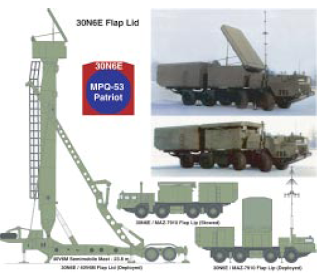S-300P’s 30N6 Missile System
The first generation of the S-300P’s 30N6 Flap Lid A engagement/ fire control radar was also innovative, and clearly influenced by the Raytheon MPQ-53 engagement radar for the MIM-104 Patriot. The Flap Lid, like the MPQ-53, uses a transmissive passive shifter technology phased array, with a space (aka optical) feed
into the rear plane of the antenna, using a microwave lens rather than a horn feed.
The Flap Lid’s antenna stows flat on the roof of the radar cabin, which was initially deployed on a trailer towed by a Ural-357, KrAZ-255 or KrAZ-260 6x6 tractor. The whole radar cabin is mounted on a turntable and used to slew the phased array to cover a 60 degree sector of interest.
 The 30N6 was a huge generational leap in technology from the Fan Song, Low Blow and Square Pair mechanically steered and scanned engagement radars on preceding V-PVO SAMs. With electronic beam steering, very low sidelobes and a narrow pencil beam mainlobe, the 30N6 phased array is more difficult to detect and track by an aircraft’s warning receiver when not directly painted by the radar, and vastly more difficult to jam. While it may have detectable backlobes, these are likely to be hard to detect from the forward sector of the radar. As most anti-radiation missiles rely on sidelobes to home in, the choice of engagement geometry is critical in attempting to kill a Flap Lid.
The 30N6 was a huge generational leap in technology from the Fan Song, Low Blow and Square Pair mechanically steered and scanned engagement radars on preceding V-PVO SAMs. With electronic beam steering, very low sidelobes and a narrow pencil beam mainlobe, the 30N6 phased array is more difficult to detect and track by an aircraft’s warning receiver when not directly painted by the radar, and vastly more difficult to jam. While it may have detectable backlobes, these are likely to be hard to detect from the forward sector of the radar. As most anti-radiation missiles rely on sidelobes to home in, the choice of engagement geometry is critical in attempting to kill a Flap Lid.The first generation of the 5V55K missile was command link guided, following the design philosophy of
the S-75/SA-2 and S-125/SA-3, with a cited range of 25nm (46km) and altitude limits between 80ft and 80,000ft. This variant was designated the S-300PT (P – PVO, T –Transportiruyemiy) and incrementally upgraded models the S-300PT-1, it entered service in 1978. NATO labelled it the SA-10A Grumble.
Two search and acquisition radars were introduced to support the S-300PT, both with 360 degree coverage. The 3D 36D6/ST-68UM/5N59 Tin Shield was used for high and medium altitude targets, and the 2D 76N6 Clam Shell for low altitude low RCS targets (refer AA 10/95 for detailed analysis). An important feature of the S-300PT was the introduction of the semi-mobile 40V6, 40V6M and 40V6MD masts, towed by a MAZ-543 derived tractor, in turn based on the 1966 Scud launcher vehicle.
The 23.8 metre tall 40V6, 40V6M could be used to elevate the Clam Shell, Tin Shield and Flap Lid radars to extend their radar horizon and improve clearance in uneven terrain. The ‘double height’ 37.8 metre tall 40V6MD appears to have only been used with the Clam Shell and its recent 96L6 replacement. The masts take one to two hours to erect.
The unique 40V6 series masts permit static or semi-mobile S-300P series SAM systems extended low level coverage not available in any competing western designs, and were clearly introduced to defeat SAC’s low level FB-111A, B-52G/H and B-1B force – and the AGM-86B cruise missile. These masts continue to be marketed as an accessory for the latest production variants of S-300P radars.
The 36D6 Tin Shield is semi-mobile and towed by a KrAZ-255 or -260 tractor, it can be deployed or stowed in one hour, or two with the mast. The design uses a large paraboloid cylindrical section primary reflector and a linear element array deployed on a pair of booms to provide electronic beam steering in elevation from -20 to +30 degrees, the antenna can perform a full 360 degree sweep in five to 10 seconds.
With a transmitter peak power rating cited between 1.23 MegaWatts and 350 kiloWatts, the manufacturer claims the ability to detect a 0.1 square metre RCS target at 300ft AGL out to 24.8nm (46km), and at medium to high altitudes to 94.5nm (175km). Clutter rejection is claimed to exceed 48 dB, and the system can track 100 targets. An IFF system is integrated in the radar.
















0 comments:
Post a Comment